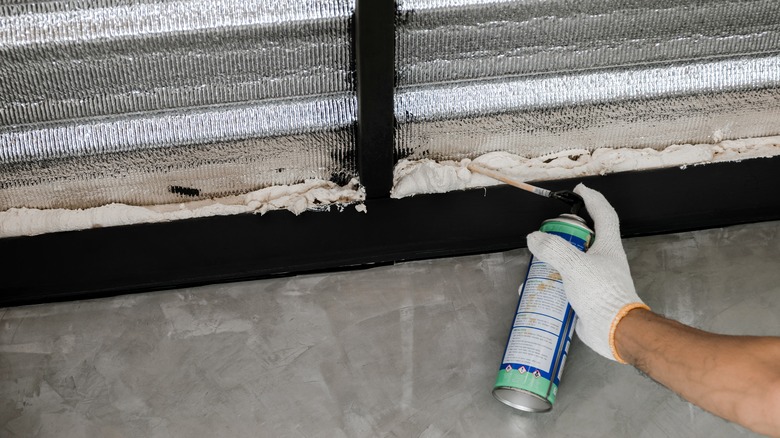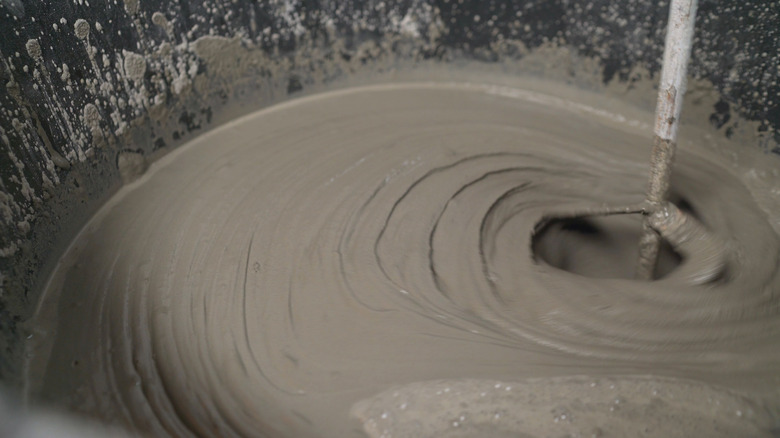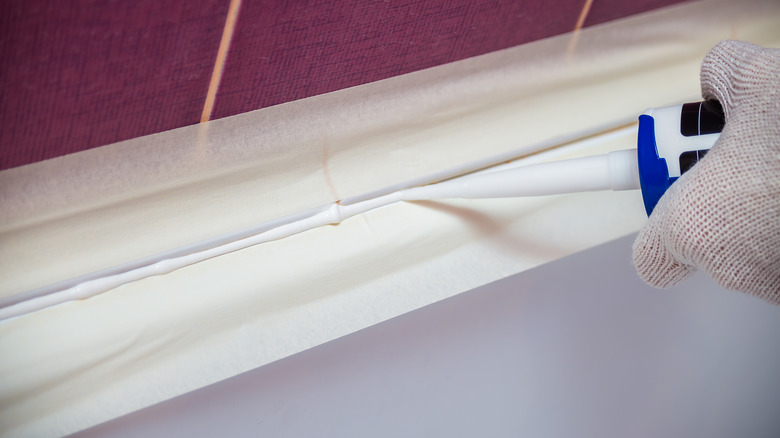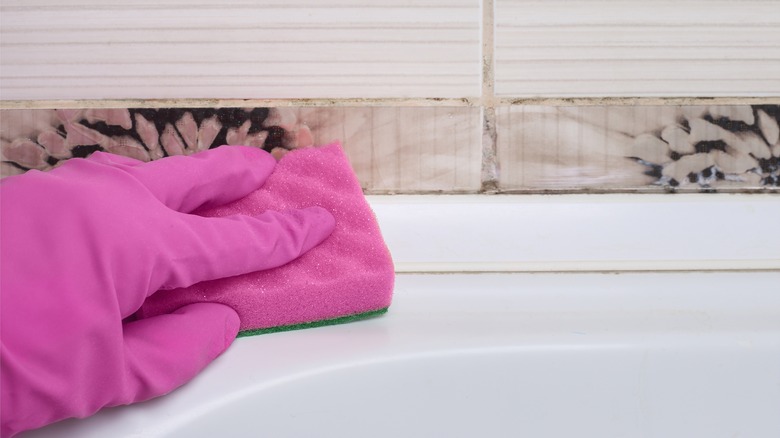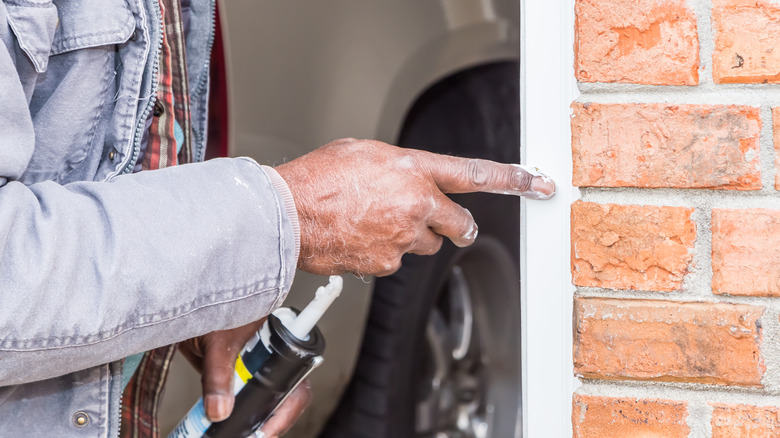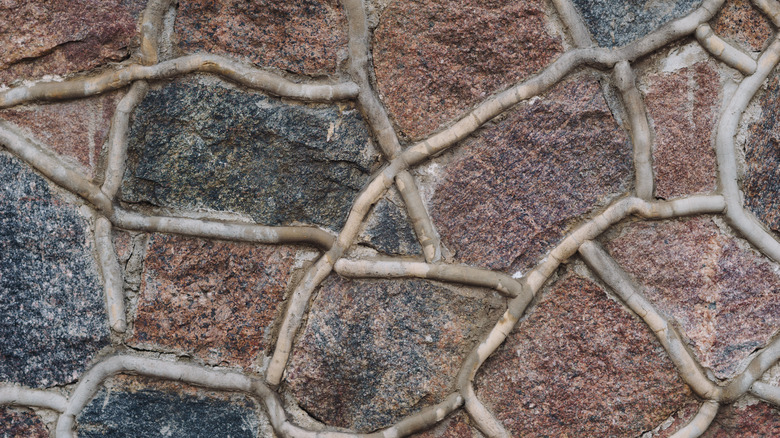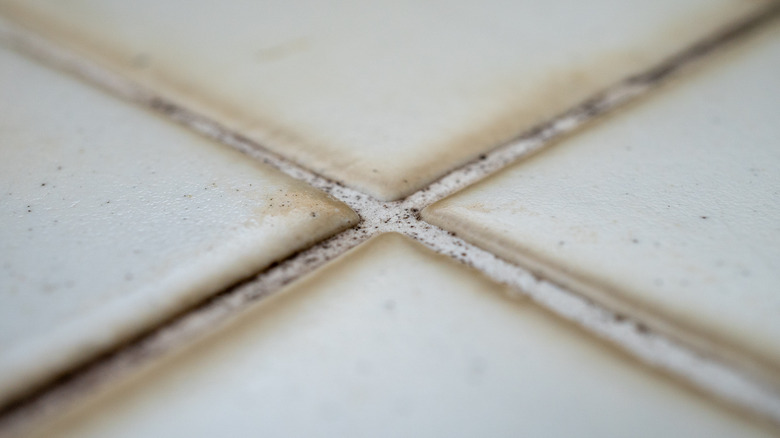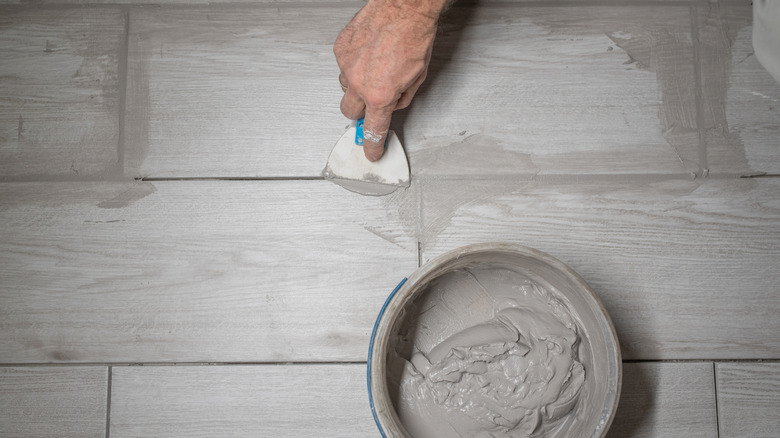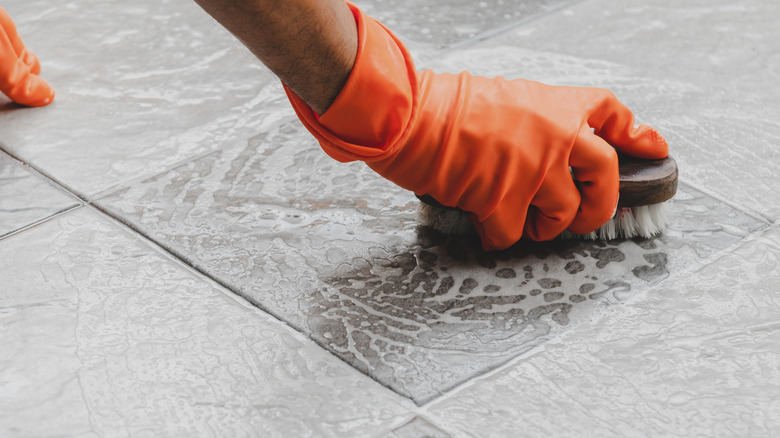Caulk Vs Grout: Which One Should You Use?
When it comes to installing, repairing, and sealing things within your home, there are two major household sealants you can choose from: caulk and grout. Although these two sealants are used in a similar way and are both useful for a variety of do-it-yourself projects or repairs, they are two distinctly different products that cannot be used interchangeably, explains Bob Vila.
PJ Fitzpatrick mentions that caulk is a versatile, flexible, rubber-like substance that can be used to repair cracks, holes, and crevices around your home. Grout, on the other hand, is a completely different product that is usually only used for wall tiles or stone flooring. Also, unlike caulk, grout becomes very stiff and hard when it dries. If you are unsure which of these two sealants to use for specific household projects, this article will define the differences and explain which one is best to use in each situation.
How does the composition differ?
As mentioned, caulk is a rubber-like substance that can be used to properly seal and protect bathroom fixtures. According to PJ Fitzpatrick, caulk is made from a variety of polymers, which give the substance its flexibility. These polymers can include silicone, latex, rubber, or polyurethane. Home Depot states that silicone caulk is usually the most commonly used due to its high durability, flexibility, and moisture repelling abilities. It is also known for being able to endure extreme temperatures.
Grout, on the other hand, has a completely different consistency as it is made from a combination of water, cement, and sand. These substances generally do not have any flexibility once they have dried, therefore, grout is usually used to fill in the gaps between tiles or stone. When choosing the best type of grout for your home project, The Tile Doctor states that the three main groups are epoxy, acrylic, and urethane. Epoxy grout tends to be the top choice for tile installations, due to its ability to resist cracking and staining, notes Zephyr and Stone.
How does the appearance differ?
Once dry, caulk and grout take on distinctly different looks. As The Tile Doctor explains, caulk is a rather glossy substance that brings a smooth, crisp edging to the objects it seals. In addition, caulk can be purchased in a variety of neutral colors, including white, beige, brown, and black (per Loctite). The most common color, however, is white because it matches most common bathroom designs.
Grout tends to take on a rough, grainy look compared to the crisp and smooth edging that caulk provides. Grout is also available in a range of colors, usually shades of white and grey. When choosing a grout color, Jeffery Court suggests choosing a color that is either a couple of shades lighter or darker than your tile. Although the color of the grout may not seem too important, it can bring out the patterns of your tiles and stone along with the overall design of the room.
What is the difference in cost?
Depending on the specific type of caulk or grout you choose, the price can vary significantly. Home Depot states that a basic tube of silicone caulk, which contains 10.1 ounces, costs around $4.00, whereas, a more hard-wearing version will likely increase to around $12. Additionally, you will need to purchase a caulk gun in order to evenly and effectively apply it to the desired surfaces. Home Depot notes that caulk guns can range from $11 to nearly $330, depending on the quality.
Grout is sold in bags of various sizes, ranging from 10 to 25 pounds. It usually comes in powder form and is mixed with water before use. An average 25-pound bag costs around $15, but premium brands can cost much more. Alternatively, there are also pre-mixed options available, where the grout comes ready to use, however, this can cost up to $30 a gallon. Along with the grout itself, you will also need a bucket for mixing, a rubberized float and sponge to apply the grout, and possibly an additive to avoid watermarks and other stains. These items can usually be purchased for under $30, notes The Spruce.
What is the difference in odor?
Hunker states that one of the biggest downsides to using silicone caulking is its odor. Caulk contains a variety of chemicals that produce odors comparable to vinegar. This strong smell can cause dizziness and lightheadedness. Although the small will be especially strong for the first few days, it should slowly start to disappear until it is no longer recognizable.
Grout, on the other hand, tends to have a very mild odor that is usually not bothersome at all. Nevertheless, some grout, for instance, epoxy grout, can give off unpleasant odors that are potentially harmful when inhaled in large amounts, warns The Tile Doctor. Thankfully, similar to caulk, any odors will immediately start disappearing as soon as the grout begins to dry.
Pros of using caulk
Caulk can be used as a sealant in many parts of your home, bringing a variety of benefits. First and foremost, caulk is the ideal material to use when sealing gaps. Whether in your shower area or on the exterior of your home, caulk provides an air-tight, water-resistant seal. This can also help save energy by preventing cool or warm air from escaping your home, ultimately saving you money, too. Caulk can also be used to prevent bugs from infesting your home by completely blocking off cracks and crevices around windows or in masonry.
By using caulk as your chosen sealant around the home, American Seaboard states that the areas will retain their crisp, clean look for a longer period of time, due to its ability to fight and prevent mildew. Once cured, acrylic caulk can be painted and is also a very easy material to clean.
Cons of using caulk
Although using caulk comes with a variety of benefits, there are also a few downsides. Most types of caulk you can purchase at the store require the use of a caulk gun, which makes applying it much easier. But even with a caulk gun, it can still be a very messy task. Caulk is a naturally sticky material, which can be tricky to apply and hard to remove, especially if used on porous surfaces.
Other than the messiness of the task, Bartleby Research also states that silicone caulk cannot be painted over. This means that if you plan on sealing or patching an area that needs to be painted, this may not be the best material to use for the task. In addition, when painting over acrylic caulk, most paints will not stay on its surface for long without chipping or rubbing away, potentially ruining the look of the area.
Pros of using grout
When installing tiles or stone in your home, grout has a variety of benefits. Tile Outlets of America specifically states that as far as appearance goes, grout can help your tile or stone wall or floor stand out, giving them a crisp edge and helping their patterns shines.
Other than improving the look of your tiles or stones, grout also greatly assists the installation process by making your floor stronger and holding the pieces together similar to cement. Grout also fills in the cracks between and underneath the tiles, which prevents dirt and other household debris from getting stuck in those small, hard-to-reach areas.
Cons of using grout
Custom Expressions shared some insights on the downsides of using grout. Unlike the tile or stone that grout is used to install, the grout alone is a rather weak material. This means that although your tile and stone can withstand pressure and a variety of household accidents, your grout may not be able to do the same. Similarly, as stone and tile tends to last for a significant amount of time without wearing away, grout has a tendency to wear down pretty quickly, leading to the possible need for replacement.
Cleaning grout can also be difficult. Unless the grout you choose is sealed or has an additive that makes it resistant to stains, grout can easily become discolored, especially in damp areas such as a shower or around a bathtub.
How easy are they to DIY?
Bob Vila states that caulking is not a difficult task and can easily be done on your own. Start by simply removing any old caulk with a sharp knife or a scraper, then steadily squeeze the new caulk onto the area using a caulking gun. Painter's tape can also be used to guide your caulking. When finished, smooth out the caulked area with your finger or a damp cloth and quickly clean any spilled caulk before it dries.
By comparison, using grout is a little more difficult. Ad It Yourself recommends that you start by mixing your grout to a creamy consistency. Then, working in small sections, use a grout float to gently push the grout in between the stones or tiles, clearing away any extra grout as you go. After the grout has partially dried, finish by thoroughly cleaning the tiles with a wet sponge.
Durability and maintenance
Compared to grout, caulk tends to be more durable, due to its flexible rubber-like qualities and its ability to endure in a variety of places both inside and outside your home. American Seaboard also mentions that caulk remains very easy to clean, maintain, and even replace when it becomes necessary.
In contrast, Custom Expressions states that grout is not considered to be as durable or easy to clean. Grout has a tendency or crack and wear down rather quickly. Bob Vila also mentions that grout can be very difficult to clean, especially if it becomes stained, but with a bit of elbow grease, Bob Vila also states your grout can be effectively maintained or restored.
Recommended use for each
As mentioned before, caulk and grout are two very different types of household sealants, which are intended for two very different types of use. To put it simply, Bob Vila states that caulk is mainly used to fill seams in a variety of places around your house, including windows, baseboards, showers, or anywhere there might be a leak or a draft.
Grout, on the other hand, is strictly used for filling the gaps between tiles or stones. Compared to grout, caulk is much more versatile in the areas it can be used, regardless of if that's inside or outside your home.
